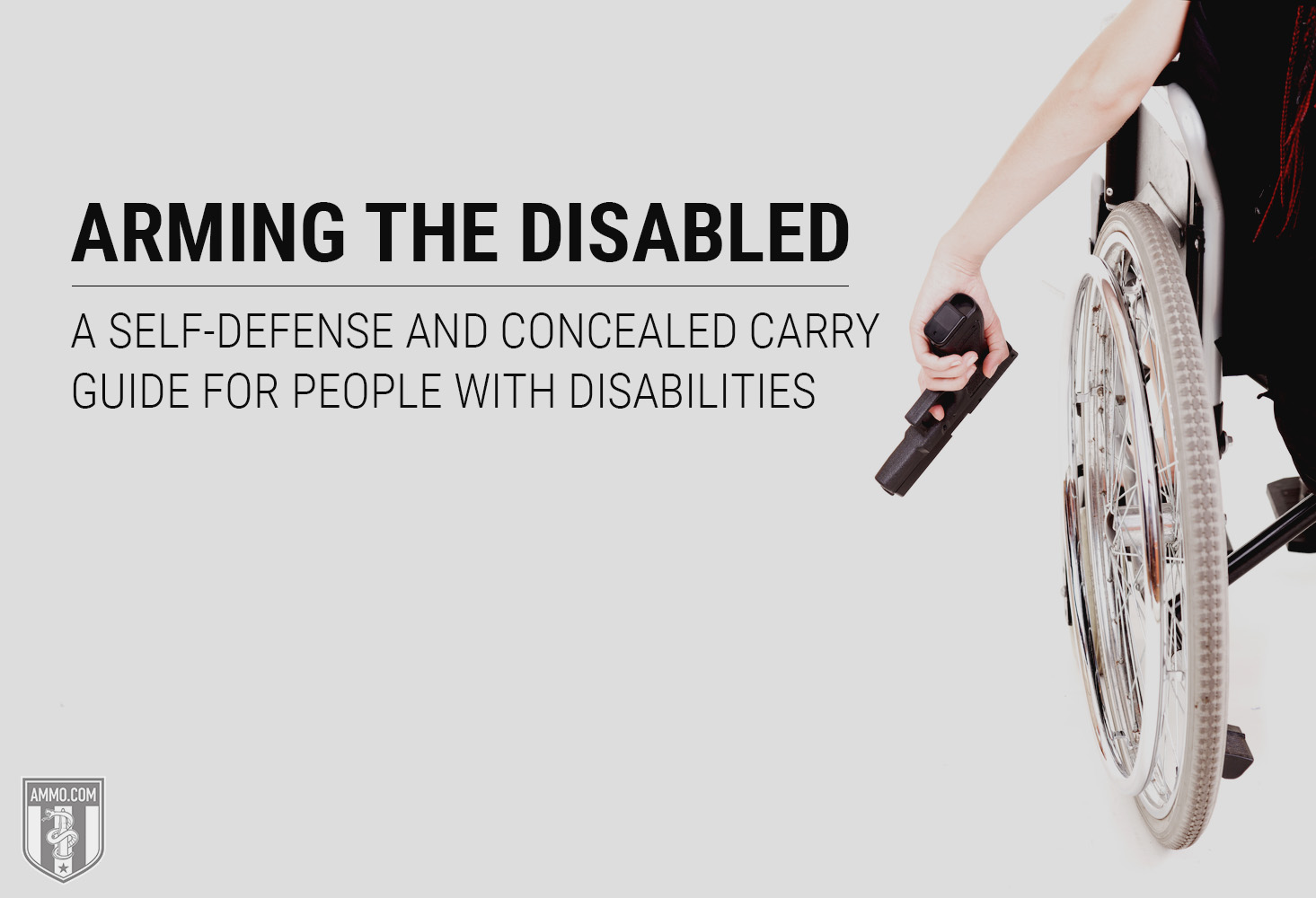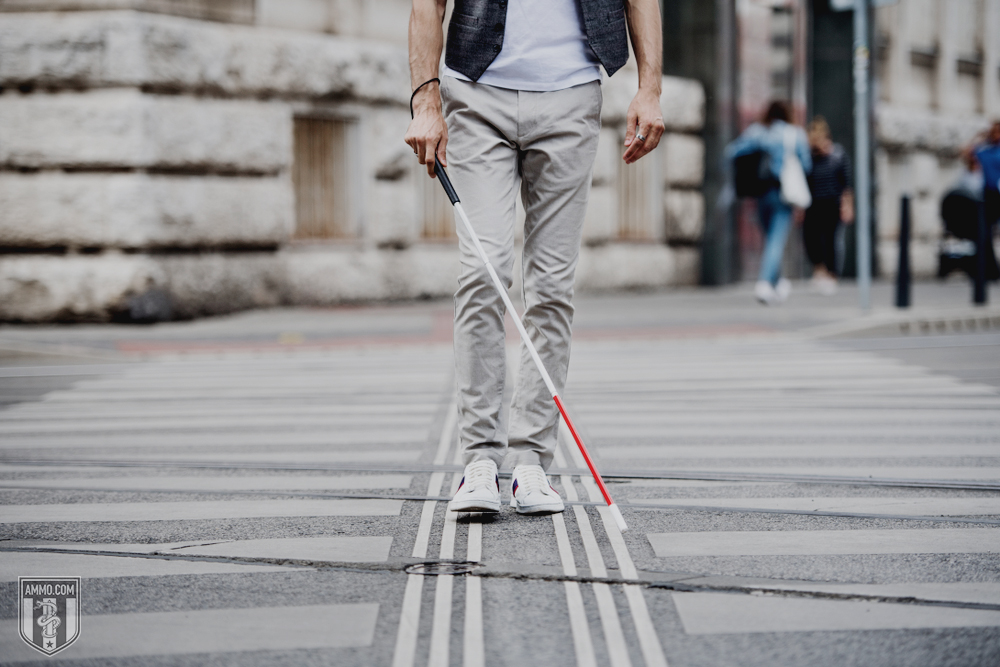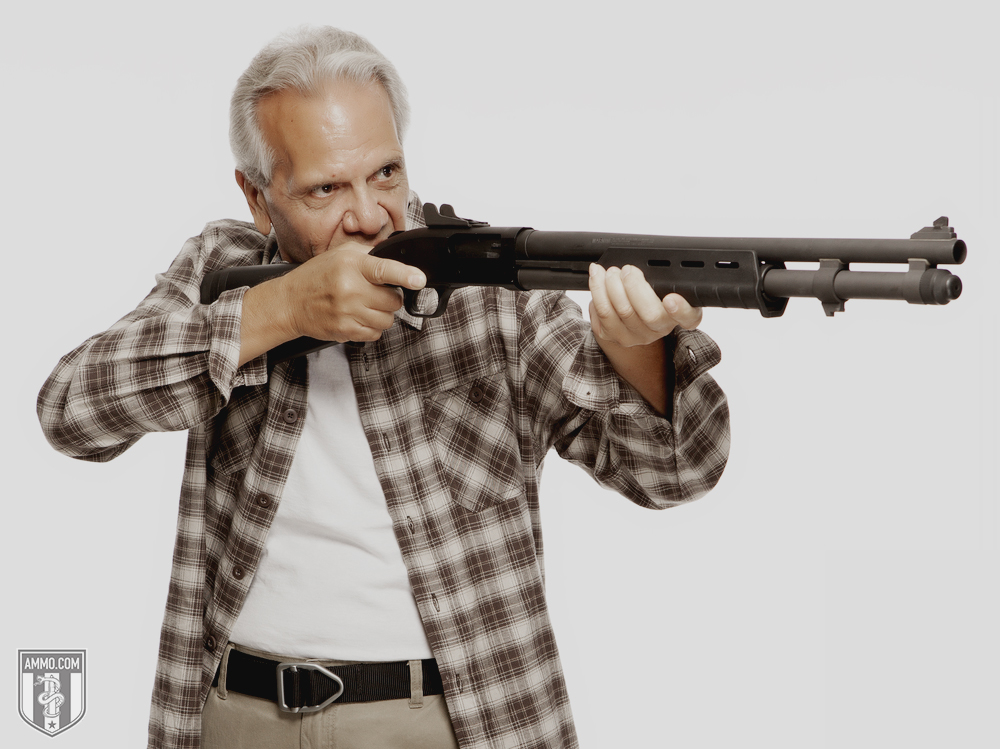Arming the Disabled: A Self-Defense and Concealed Carry Guide for People With Disabilities
You're free to republish or share any of our articles (either in part or in full), which are licensed under a Creative Commons Attribution 4.0 International License. Our only requirement is that you give Ammo.com appropriate credit by linking to the original article. Spread the word; knowledge is power!
 An estimated 56.7 million Americans, around 19 percent of the U.S. population, is considered disabled, which means they have a physical or mental condition that limits their movements, their activities, or how they sense the world around them. While these individuals are faced with difficulties every day, they also have a greater risk of being a victim of violent crime.
An estimated 56.7 million Americans, around 19 percent of the U.S. population, is considered disabled, which means they have a physical or mental condition that limits their movements, their activities, or how they sense the world around them. While these individuals are faced with difficulties every day, they also have a greater risk of being a victim of violent crime.
According to the 2015 Department of Justice report Crimes Against Persons with Disabilities, those with disabilities suffer violent victimization at a rate of 295 victimizations per 1,000 people, which is 2.5 times more than those without disabilities (who have a rate of 11.8 victimizations per 1,000 people). Of these victims, it’s estimated that one in five is targeted because of their disability.
What’s worse, people with disabilities have a three-times-higher rate of becoming a victim of a serious violent crime – which includes rape, sexual assault, robbery, and aggravated assault – than someone without a disability. Even simple assault occurs twice as often to this population when compared to the general public (19.6 per 1,000 people versus 8.7).
Sadly, other than offering victim services, few programs have been available to increase the prevention of victimization for those with disabilities and teach some level of self defense. Many look at disabled individuals as people who can’t take care of themselves and scoff at people in wheelchairs seeking self-defense training.
But it doesn’t have to be this way. Most people, whether disabled or not, can learn some level of self defense that can help protect both their physical person, as well as their home and belongings. While there may be obstacles, with patience, the proper training, and a little bit of time, most people with disabilities are just as capable of protecting themselves as those without disabilities.
Don’t Be a Target
 There are generally six types of recognized disabilities:
There are generally six types of recognized disabilities:
- Physical
- Vision
- Hearing
- Mental health
- Intellectual
- Learning
These issues make many people with disabilities more vulnerable than those without. They may not see a perpetrator coming or be able to hear a person walking up behind them. They may not be able to move as quickly or fight back against an attacker. Perhaps they’re more trusting, naive, or become easily confused.
Regardless of the disability, the first step in self defense is reducing the likelihood of being a victim and learning how to not be targeted by a criminal.
To start, become more aware of your surroundings. If you see something that makes you uncomfortable, avoid it. Afterall, preventing a violent incident is always better than defending yourself in one.
These tips can reduce the risk of being targeted:
- Move with purpose. Know where you’re going and the safest way to get there.
- Have a Plan B. Know an alternative route, especially if you have to travel through unsafe areas.
- Look confident. Keep your eyes up and your back straight. Don’t hunch and don’t act meek.
- Know where the exits are. From bathrooms to parking garages, know the quickest route out of the room and building.
- Avoid being alone, especially when you know you’ll be in unsafe areas or around suspicious people. If you must travel by yourself, ensure someone knows where you’re going, when you should arrive, and the route you’re taking.
- Travel during the day. Keep your errand-running to daylight hours and avoid going out at night when it’s easier for crimes to occur. If you do go out, stay in well-lit areas and avoid high-risk neighborhoods.
- Stay off your screen. Take out your earbuds. And get your nose out of the phone. Pay attention to what’s going on around you and don’t allow yourself to be distracted.
- Use props. If you have mobility issues, use a luggage or pull-behind cart when you’re carrying things like laundry or groceries. This keeps your hands free and accessible.
- Hide your valuables. Opt for a travel wallet, which keeps your money and cards hidden in your waistband and away from the eyes of criminals. If you carry a purse, wear it inside your jacket. And only carry what you need. If you don’t need $1,000 and five credit cards, leave them at home.
- Carry a tool. Whether it’s your keys, a kubaton, or a can of pepper spray, keep some type of self-defense tool nearby.
- Don’t be overly trusting. Never open your door to a stranger and don’t give out personal information. If someone seems suspicious or dangerous, trust your gut and stay away.
Opting for Self Protection and Self Defense
A person can be disabled and still protect themselves. Yes, they may have to train harder. And yes, they may need to make some modifications. But with the right knowledge and skills, self defense is available to most people, regardless of their limitations.
If you want to learn how to protect or defend yourself against a criminal, you must train. Repetitive practice gives you the knowhow and confidence to act when and if necessary.
Seek out a local self-defense trainer and ask if they offer classes for people with disabilities. If they don’t, ask for a recommendation for someone who does. There are classes from coast to coast that teach people how to use leverage and pressure points in self defense, even when the attacker is larger or more agile than the victim.
In addition to training, keep these self-defense tips in mind:
- Avoid the fight when possible. When it becomes clear that a crime is about to be committed, don’t just go along with it. Get loud. Draw the attention of bystanders. Blow a whistle. Make a commotion.
- Stay out of reach. Don’t let the perpetrator get within arm’s reach. If they want your bag or wallet, don’t hand it to them, throw it as far away from you as you can. Move away from the attacker and don’t allow them to back you into a wall.
- Use what you have. Use whatever you have to protect yourself. Swing your purse at the attacker’s head to stun them. If you use a cane, use it like a staff or club to fight back.
- Fight dirty. Although you should avoid hand-to-hand combat at all costs, if you must fight, fight dirty. Poke at the eyes. Knee the groin. Break the nose. Fight like your life depends on it. Use the elbows to make short, sharp jabs and engage in hard knee thrusts.
- Never get in the car. If an attacker tries to get you into a vehicle, do everything you can to stop them. Once they’ve moved you to another location, it becomes even harder for help to find you.
Concealed Carry Basics for People with Disabilities
 Those who want the best self defense possible may consider carrying concealed. Choosing to carry concealed is a personal decision and only you can decide if it’s the right thing for you. If you’re willing to train with it and if you’re legally allowed to carry concealed, carrying a firearm does offer a level of protection that nothing else can.
Those who want the best self defense possible may consider carrying concealed. Choosing to carry concealed is a personal decision and only you can decide if it’s the right thing for you. If you’re willing to train with it and if you’re legally allowed to carry concealed, carrying a firearm does offer a level of protection that nothing else can.
The Right Weapon
The first step to carrying concealed is finding the right weapon. For a concealed carry weapon (CCW) to be effective, the user must be able to control the firearm and utilize its functions. This includes:
- Racking the firearm
- Pulling the trigger
- Handling the recoil
- Stabilizing the gun
For many, this means choosing a 9mm or .380 pistol over a .357 revolver or 12 gauge shotgun. A smaller caliber that you have the manual dexterity and strength to handle will protect you much better than a larger caliber you can’t control.
The Right Training
Once you have the right firearm, you must start training. You have to learn how to handle, fire, and care for your gun to be effective at self defense. And your training shouldn’t just consist of standing in front of a target and shooting a box of ammunition. That’s target practice. You need self-defense training.
With regular and continued practice, your firearm can become an extension of yourself. To make that happen, you need to practice with your CCW often. And not just until you’re efficient, but always.
Practice pulling your gun from your holster from all different positions: standing, sitting, and lying down. Learn to fire it with both hands. Learn how to rack it without your free hand. Use snap caps or rubber bullets and role play any and all situations you can think of, from being in the shower to getting in your vehicle.
The Right Holster
Almost as important as the right firearm, you must have the right holster if you want to carry concealed. Firearms are unsafe carried loose in your pocket or bag. And, although primetime television may disagree, they’re not safe just jammed into your waistband.
You need a holster to not only keep your gun safely secured, but also to ensure that when you need it, you know exactly where it is. A good holster makes drawing your CCW easier and more consistent than fumbling around trying to find it.
The right holster for you depends on your size, shape, firearm, and disability. And you may have to try a few different holsters before you find the right fit. To help you along the way, look for these qualities in a CCW holster:
- Fit: You want a holster that fits snug against the body and stays in place when you move around.
- Retention: Your holster should hold your firearm tight, so tight that it won’t slip out during an altercation, even if you fall onto the floor.
- Presentation: Although you want good retention, your holster shouldn’t be so tight that you can’t withdraw it when needed. Instead, it should have a smooth presentation that allows you to draw your firearm and put it back without issue.
- Concealability: If you’re going to carry concealed, your holster should hide your weapon, not draw attention to it or imprint through your clothing.
- Protection: A good holster protects your gun from outside elements, as well as from your body’s sweat and oils.
- Comfort: If your holster isn’t comfortable, you won’t wear it. So ensure it doesn’t rub against your skin or dig into your hips.
If at all possible, use a holster that’s on your body. A firearm is always safer when you’re wearing it on you than when it’s in a purse or jacket. That being said, sometimes off-the-body holsters are necessary, especially for those with certain disabilities. Look for customized CCW jackets or purses, which can even be found with locks that protect your firearm from other’s hands.
CCW Suggestions for People with Disabilities
When it comes to concealed carry weapons, there are basically two options: semi-automatic pistols and revolvers. They both have their pros and cons, and some will be better suited for certain individuals. But for most, it’s simply a matter of preference.
Semi-Automatics
Semi-autos are magazine-fed handguns that after the initial racking, fire a bullet every time you pull the trigger. The faster the trigger is pulled, the faster the gun fires. For those with dexterity problems or who lack hand strength, pulling back the slide of some firearms may present a challenge. Look for an easy-to-handle slide and practice racking the gun with both hands before you buy it.
A good option to try is the Smith & Wesson M&P 380 Shield EZ. This .380 caliber pistol is designed to be easy to slide and easy to load, perfect for CCW novices. It also contains multiple safety features, including both a grip and trigger safety mechanism. Other good options include the Kel-Tec P32, which comes in .32 ACP, a caliber that’s small, but quite effective with the right training, and the SIG Sauer P239.
Revolvers
For those who lack the hand strength or fine motor skills to maneuver a semi-automatic slide, a revolver offers an easier option. Wheel guns have no slide and no intricate safety mechanisms, but the shooter needs to have the strength for the long, and sometimes heavy, trigger pull. While triggers can be changed out, the long pull offers a safety to prevent accidental firing.
When looking at revolvers, two good options include the Ruger SP101 in .327 Mag, a short, but powerful round, and any Smith & Wesson J-Frame chambered for the .38 Special.
Small Calibers
Don’t fall victim to thinking a smaller caliber is always better for shooters with disabilities. For instance, .22 calibers are available in both semi-autos and wheel guns. Although they’re easy to shoot, these rimfire cartridges aren’t recommended for self defense (and neither are the somewhat obscure and slightly larger .25 ACP bullets). While they can be deadly, their stopping power is unreliable, especially in high-stress situations.
That being said, if your disability impacts you in such a way that you can only handle a .22, then a small gun is better than no gun. To get the most from a .22, opt for a mini-revolver by North American Arms chambered in .22LR or .22 Win Mag.
Overcoming Disability Obstacles to Carry Concealed
 While having limitations to carry concealed can be frustrating, knowing your obstacles gives you the opportunity to prepare for them and be ready when in a life-or-death situation. Some of the most common physical limitations that impact shooters with disabilities include:
While having limitations to carry concealed can be frustrating, knowing your obstacles gives you the opportunity to prepare for them and be ready when in a life-or-death situation. Some of the most common physical limitations that impact shooters with disabilities include:
- Limited range of motion: When your disability causes a limited range of motion, reaching behind your back can cause pain and make drawing your CCW difficult. Try a shoulder holster or clip holster on your dominant hip. Beware of snap holsters, as they can be hard to unfasten and re-secure.
- Poor hand strength: If you use a semi-automatic pistol and have limited hand strength, opt for a pistol with an easy-to-use slide or one with a tip-up barrel. Or choose a revolver, just ensure you have enough finger strength to fully engage the trigger.
- Problems with balance: For those who struggle with balance, choose a handgun that’s light and has limited recoil. Wearing a snug shoulder allows you to easily access your handgun and won’t throw you off balance like reaching behind the hip for an in-the-waistband holster. If the shoulder holster still gives you trouble, consider a pocket pistol nestled in a pocket holster.
- Chronic pain: When you have chronic pain, carrying a concealed weapon can trigger more pain. To make the least impact possible, choose a small, lightweight firearm that won’t influence your gait or change how you sit. A holster that sits low and tight to your hip can be convenient and easy to reach, but many may find that a belly band is the most comfortable option.
- Vision impairment: Most self-defense situations occur within 10 feet, which means even those with poor eyesight can often see rather well. Adding a light to your CCW can aid in seeing during the night as can wearing corrective lenses. A laser can also be a huge benefit and can boost your confidence when in a threatening situation.
When Concealed Carry Isn’t Possible
For people with some disabilities, concealed carry isn’t possible. Most notably, if an individual has a mental health disability and has been adjudicated as a mental defective or has been court ordered into a mental health hospital, they will not pass a gun background check, which means they can not purchase a firearm. If the disabled person is known to have a substance abuse addiction and has been court ordered to a drug and alcohol rehabilitation center, they will also fail the background check.
Other times, a person’s vision can impact their ability to carry concealed. In Iowa, which is a shall issue state, not a may issue, sheriffs issue concealed carry permits to residents with visual impairments, as the state has determined that no disability shall infringe on a person’s right to bear arms. Since up to 80 percent of people considered legally blind still have some vision, the people of Iowa feel it necessary to hold up the Second Amendment to the best of their ability. The state does require a mandatory gun-training session, but the session does not include a live fire test.
Regardless of the reason, if your disability holds you back from carrying concealed, there are other options – including self-defense classes designed for those with disabilities.
Disability-specific courses are available, such as for those in wheelchairs or classes like Sightless Self-Defense, a unique blend of martial arts that works on balance, mobility, and mental imaging to teach self defense.
When a Self-Defense Situation Arises
 If you find yourself in a self-defense situation, stay calm. Remember your training. If you’re in public, get loud. If you’re at home and someone is with you, have them call 911. Announce yourself to the intruder and the fact that you’re armed, and tell them to leave. Tell them you will shoot.
If you find yourself in a self-defense situation, stay calm. Remember your training. If you’re in public, get loud. If you’re at home and someone is with you, have them call 911. Announce yourself to the intruder and the fact that you’re armed, and tell them to leave. Tell them you will shoot.
Only shoot if you believe your life is in immediate danger. If the attacker has their back to you, you’re NOT in immediate danger. If they don’t have a gun and are standing 20 yards away, you’re NOT in immediate danger.
Most self-defense situations occur in close proximity, so aim small, meaning don’t aim at the person’s chest, aim for a specific spot, such as a button, on their shirt.
For the home, you may want to consider a shotgun, especially if you struggle with fine motor skills, as shotguns are easy to rack. And be sure to rack the gun within earshot of the perpetrator. In many cases, that sound is enough to express your seriousness and make an intruder turn tail and run.
If you end up using a lethal weapon in self defense, call 911 and tell them what happened. Set your firearm aside and wait for the police to show up. Expect to be handcuffed, especially if shots were fired – but don’t take any of this personal; a gun has been fired, perhaps a person has been shot, and the police need to figure out what happened and ensure everyone’s safety.
If you become a victim of a crime, report it. It’s estimated that over half of the nation’s violent crimes go unreported. Don’t be embarrassed or afraid. When people don’t report crimes against them, criminals continue to commit crimes.
Self defense for the disabled needs to become a priority. It’s time to throw away the biases and self doubt, and learn how to protect yourself against crimes and reduce your risk of victimization.
Self Defense
- Arming Yourself: A Woman's Guide to Self Defense and Concealed Carry (CCW)
- Protecting Your Family: A Parent's Guide to Self Defense and Concealed Carry (CCW)
- Arming the Elderly: A Self-Defense Guide for Senior Citizens
- Holsters for Self Defense: A Guide to Carrying Concealed
- Arming Toddlers and The "Kinder-Guardians" Program: A Shamefully Bad Idea
- Handgun Wounding Factors: A Caliber Effectiveness Guide for Self Defense and Body Damage
- Self Defense for LGBT: Self-Protection and Concealed Carry (CCW) for the LGBT Community
- Arming the Disabled: A Self-Defense and Concealed Carry Guide for People With Disabilities
